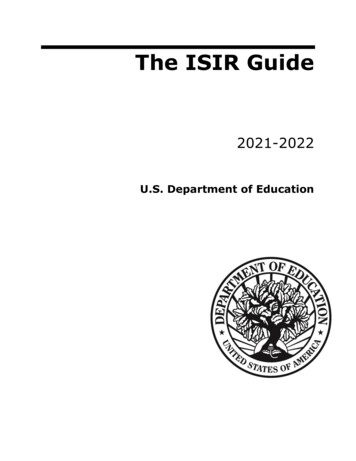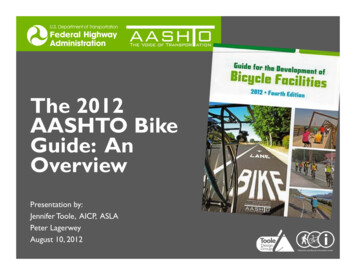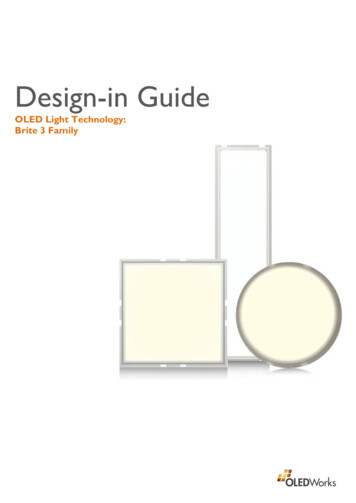
Transcription
The ISIR Guide2021-2022U.S. Department of Education
Change History TableThe Change History table is updated each time The ISIR Guide is modified, providing acumulative list of revisions made to the document.When The ISIR Guide is modified, the footer is updated to include the revision date. Forexample, if a change is made to page 67 in December 2021, the footer on that page will show“Rev. 12/21.”DatePage7/2012/2112/21Changes/NotesISIR Guide initial release37SSN Match Flag – We updated the description for value “5.”38SSA Match Flag – We revised the second “Blank” value to read,“ No match conducted if SSN Match Flag does not equal 4.”It previously read, “ No match conducted if SSN Match Flag equals 8(Record not sent to the SSA) or Blank (Match not performed).”Parent 1 SSN and Parent 2 SSN Match Flags – We revised the description forvalues “Blank” and “5.”12/2141 Blank Record not sent to match or match not performed.It previously read, “Match not performed.”5 SSN, name, and date of birth match but includes a death indicator.It previously read, “SSN, name, date of birth match with date of death.”12/21A-2We added a “New for 2021-2022” note to describe the year reference inrejects “A” and “B” and updated description for reject “8” from “date ofdeath” to “death indicator.”12/21A-4We updated reject “8” from “SSN match with date of death” to “SSN matchwith death indicator.”July 2020 (2021-2022) Rev. 12/21The ISIR GuideCH-i
Table of ContentsINTRODUCTION . 1Overview . 1Processing Flow . 4Federal Application Processing System Paper and Electronic Processes to Generatean ISIR . 6Federal Application Processing System Web Process to Generate an ISIR . 7Federal Application Processing System for myStudentAid Mobile Application toGenerate an ISIR . 8Transactions . 9Highlights and Assumptions . 10Paper System Highlights and Assumptions . 10Electronic System Highlights and Assumptions . 11ISIR DATA . 12Overview . 12Cover Page . 13FAFSA Questions . 14Notes about Federal School Codes . 14Asset Threshold Exceeded . 15Dependency Status Results . 16Office Information . 17Primary and Secondary EFC Types . 17Transaction Processed Date . 17Transaction Data Source/Type Code . 18Reject and Assumption Override Codes . 19Source of Correction . 20July 2020 (2021-2022)The ISIR Guidei
Federal School Code Indicator. 20FAA Information . 21Date ISIR Received. 21Verification Flag . 21Professional Judgment Flag . 21Transaction Receipt Date . 22Reprocessed Reason Code . 22Processed Record Type . 22CPS Pushed ISIR . 23Rejects Met . 23Verification Tracking Flag . 23Dependency Override Indicator . 24ETI . 25Correction # Applied To . 25Application Receipt Date . 26Pell Eligible Flag. 26Primary and Secondary EFCs/Alternate EFCs . 26Intermediate Values . 27IRS Data Flags . 28IRS Request Flags . 28IRS Display Flags . 29IRS Data Field Flags . 31CFH Indicator . 32Duplicate SSN Flag. 32Address Only Correction . 33SAR C Change Flag . 33High School Flag . 33Rejected Status Change Flag . 34Verification Selection Flag . 34EFC Change Flag . 34Special Circumstance Flag . 35Auto Zero EFC Flag. 36SNT Flag . 36Match Flags . 36SSN Match Flag . 37SSA Match Flag . 38July 2020 (2021-2022)The ISIR Guideii
DHS Match Flag . 38SS Match Flag . 39NSLDS Match Flag. 39VA Match Flag . 40DHS Sec. Conf. Match Flag . 40Parent 1 SSN and Parent 2 SSN Match Flags . 41DOD Match Flag. 41DHS Verification # . 43SS Registration Flag . 43NSLDS Transaction Number . 43NSLDS Database Results Flag . 44Comments . 44NSLDS Financial Aid History . 45Flags (Upper Section) . 45Discharged Loan Flag . 45Fraud Loans Flag . 45Defaulted Loans Flag . 45Loan Sat. Repayment Flag . 46Active Bankruptcy Flag . 46TEACH Grant Loan Conversion Flag . 46Unusual Enrollment History Flag . 46Postscreening Reason Codes. 47Aid Type Summary . 49Overpayment Flags . 49Contact . 49LEU % . 49Lifetime Limit Flag . 50Subsidized Usage Limit Applies Flag. 50Subsidized Usage Period. 50FFEL/Direct Loans Changed Flag and Perkins Loan Changed Flag . 50Aggregate Amounts for FFEL/Direct Loans, TEACH Loans, and Perkins Loans . 51Pell Payment Data . 52Teacher Education Assistance for College and Higher Education (TEACH Grant)Data . 53Loan Detail. 53MPN Information . 56July 2020 (2021-2022)The ISIR Guideiii
Loan Limit Information . 57Additional NSLDS Resources . 57Additional ISIR Data . 58DRN . 58Signature Reject EFC . 58Field Correction Flags. 58FAFSA Data Verify Flags . 59CORRECTIONS AND UPDATES . 60Overview . 60FAAs Making Corrections . 61FAA Access to CPS Online . 61Mainframe System . 61Students Making Corrections . 62E-mail Notification of SAR Processing . 62SAR Acknowledgement. 62SAR . 62SAR Corrections . 63Parent Information for Independent Students . 64Signatures . 65SAR Corrections . 65FSA IDs . 65Signature Rejects . 65Reject 16 — Missing Student Signature from an Electronic Application . 66Reject 15 — Missing Parent Signature on FAFSA or SAR . 66Reject 14 — Missing Student Signature on Paper FAFSA or SAR . 67School Code Corrections . 68GETTING HELP . 69Customer Service . 69FSATECH Listserv . 69CPS/SAIG Technical Help Desk . 69Federal Student Aid Information Center (FSAIC). 70July 2020 (2021-2022)The ISIR Guideiv
APPENDIX A – 2021-2022 REJECT CODES AND REJECT REASONS . A-1Reject Reason Codes . A-1Table of Reject Codes and How to Respond to Each . A-2APPENDIX B - LOAN STATUS CODES AND ELIGIBILITY CHARTS . B-1Overview . B-1Loan Status Codes . B-2Federal Loan Servicer Loan Servicing Codes . B-6Federal Loan Servicers. B-8FFEL-only Servicers . B-9Guaranty Agencies . B-15FFEL Lenders . B-16Contact Information & Fields Associated with Loan Status . B-17APPENDIX C – SAR AND SAR ACKNOWLEDGEMENT . C-1Overview . C-1Masked Values . C-2Paper SAR . C-4SAR–Page 1 . C-4SAR–Page 2 . C-5SAR–Page 3 . C-5SAR–Page 4 . C-5SAR–Pages 5-10 (Spanish Pages 5-11) . C-6SAR Acknowledgement . C-8SAR Acknowledgement–Page 1 . C-8SAR Acknowledgement–Pages 2-3 (Spanish Pages 2-4) . C-8APPENDIX D – SAMPLE 2021-2022 ISIR. D-1Overview . D-1Sample ISIR . D-2July 2020 (2021-2022)The ISIR Guidev
IntroductionOverviewThe ISIR Guide is designed to assist financial aid administrators (FAAs) with interpreting studentinformation on the Institutional Student Information Record (ISIR) and making corrections. TheISIR contains all information reported on the Free Application for Federal Student Aid(FAFSA ) form, key processing results, and National Student Loan Data System (NSLDS)financial aid history. The term ISIR refers to all processed student information records that aresent electronically to institutions by the Central Processing System (CPS).ISIRs are sent to schools through the Electronic Data Exchange (EDE), which is the U.S.Department of Education’s (ED’s) electronic service that enables schools to send data to andreceive resulting processed data from the CPS and other Federal Student Aid systems. The ISIRGuide explains codes and flags that appear as FAA information on the ISIR.Student Aid Reports (SARs) are the paper or electronic (eSAR) output documents that are sent tostudents or printed from the FAFSA on the Web and FAA Access to CPS Online Web sites.SARs and ISIRs contain the same processed student information in different formats. The SARis explained in detail in Appendix C of this guide.The 2021-2022 ISIR follows the question order of the FAFSA, and the remaining data elementsare grouped with similar elements in a logical order that we refer to as “data blocks.” After thesedata blocks—such as student demographic information, financial information, dependencydetermination questions, and parental information—filler spaces are included. When mid-cyclechanges are needed for particular data elements, we use the filler spaces to add, remove, or revisethose elements. As a result, the change affects only the existing filler blocks and not the entirerecord layout.A complete version of the EDE Technical Reference is posted to ED’s Information for FinancialAid Professionals (IFAP) Web site, located at ifap.ed.gov. It can be downloaded in portabledocument format (PDF).You can use the table below to find more information about the 2021-2022 Federal Student Aidsystem changes and enhancements. The following guides are posted on the IFAP Web site:July 2020 (2021-2022)The ISIR Guide1
DocumentType of ChangesSummary ofChanges for theApplicationProcessingSystem GuideThis guide provides an overview of major application processing systemupdates, such as: Need Analysis Income Threshold IncreaseSchedule 1 Question ChangesThis guide also covers changes to the FAFSA.It covers changes to Federal Student Aid’s Web sites for students, such as: FAFSA on the Web myStudentAid mobile appIt covers changes to Federal Student Aid’s Web sites for FAAs, such as: FAA Access to CPS Online (FAA Access)CPS Web Applications Demo SystemThis guide also includes an application processing system schedule and asummary of changes to components of the CPS, such as: Database matchesCPS editsNeed analysis changesComment code changesChanges to application output sent to students, such as the SAR andSAR AcknowledgementElectronic DataExchange (EDE)TechnicalReferenceThis technical reference includes general information about the EDEprocess, a summary of changes to the technical reference, descriptions ofthe electronic FAFSA and corrections process, information on sendingand receiving electronic data, record layouts and processing codes used tosend and receive electronic data, and information on printing an ISIR.SAR CommentCodes and TextThis document includes the comment code numbers and text along withreject code SAR C code information, data match information, andresolution descriptions.Software CoverLettersThe software cover letters describe changes and enhancements to specificreleases of Federal Student Aid PC products, such as EDExpress andDirect Loan (DL) Tools for Windows.July 2020 (2021-2022)The ISIR Guide2
Note: Throughout this guide, when we reference the FAFSA on the Web site, we are describingboth the English and Spanish versions of the site unless otherwise noted. The functionality ofthe English and Spanish versions of FAFSA on the Web are the same; the only difference is thelanguage used. Also throughout this guide, references to FAFSA on the Web pertain to themyStudentAid mobile application unless otherwise noted.July 2020 (2021-2022)The ISIR Guide3
Processing FlowThe applicant data processing flow for generating ISIRs is the same in 2021-2022 as it was in2020-2021.The student starts by submitting a FAFSA. The information is processed through the CPS, andthe results are returned to the student and institution. See the bullet point labeled “The FinancialAid Application” on the next page for filing options.The charts on pages 7 through 9 show how information from a financial aid applicant flowsthrough the system for the various types of applications and corrections and describe when anISIR is generated. The major participants, documents, and records in the application process arelisted below: The U.S. Department of Education. The Student. The student can apply for federal student aid under the following Title IVprograms: Federal Pell Grant, Teacher Education Assistance for College and HigherEducation (TEACH) Grant, Federal Supplemental Educational Opportunity Grant (FSEOG),Federal Work-Study, and William D. Ford Federal Direct Loan (Direct Loan) programs. The FSA ID for Students and Parents. The FSA ID is a username and passwordcombination that is used to confirm a person’s identity and serves as a student’s or parent’sidentifier to allow access to personal information in various ED systems. It also acts as alegally binding digital signature on some online forms. Because the FSA ID serves as anelectronic signature and provides access to personal information, the FSA ID should not becreated by anyone other than the owner of the ID. The FSA ID should not be shared withanyone, including FAAs. The FSA ID simplifies and expedites processing for an applicantand his or her parent.Students and parents must create their own FSA IDs. The FSA ID is issued in real time sothat the student or parent can use it immediately to authenticate with and retrieve data fromthe IRS and sign the FAFSA electronically, but the FSA ID cannot be used for anything elseuntil the identifying information is sent to the Social Security Administration (SSA) andmatched with that agency’s database. The Social Security Number (SSN), name, and date ofbirth submitted by the applicant or parent are transmitted for a match with the SSA. If theSSN, name, and date of birth are successfully matched (SSN Match Flag value of 4), theapplicant or parent can use the FSA ID to access a renewal FAFSA, view or print a SAR,make corrections, and access NSLDS data.In the limited cases where the SSA match is unsuccessful, the FSA ID is disabled and, if theapplicant provided an e-mail address, an e-mail is sent to notify the applicant that an FSA IDwill not be issued. If the applicant used the temporary FSA ID to sign his or her FAFSA, theapplicant is also sent a paper SAR requesting all required signatures. A SAR comment(comments 275 to 280) appears on the student’s SAR (and ISIR), indicating the specificresults of the SSA match. Until a positive match (SSN Match Flag value of 4) is receivedfrom the SSA, the FSA ID cannot be used to sign any documents or access Web sites thatrequire the FSA ID.July 2020 (2021-2022)The ISIR Guide4
The Financial Aid Application. Different forms of the application are available for thestudent to apply for federal student aid. These include English and Spanish versions of thefollowing: FAFSA on the WebmyStudentAid mobile app (English only)FAFSA PDFPaper FAFSAFAFSA on the PhoneThe school can also submit an application for the student by completing an online FAFSAthrough FAA Access to CPS Online or by submitting an ASCII flat file through the StudentAid Internet Gateway (SAIG) in message class EAPS20IN. The FAFSA Processor. One organization serves as the data-entry processor for the2021-2022 processing year under a contract with ED. The FAFSA processor receives paperapplications, paper SAR corrections, and paper signature pages in the mail; performsdocument analysis to ensure that the data is acceptable; and handles missing or unacceptableresponses. The processor images the application, enters the information from the application,and transmits the data and image electronically to the CPS. The Central Processing System (CPS). The CPS operates under a contract with ED toreceive and process application and correction information. The CPS matches studentrecords with other federal databases, such as the SSA and Department of Homeland Security,to confirm eligibility. The CPS also applies a series of compute edits to the applicationinformation to check for inconsistencies, contradictions, and missing data. During thecompute process, the CPS uses the need analysis formula specified by law to calculate eachapplicant’s Expected Family Contribution (EFC). The Institutional Student Information Record (ISIR). ISIRs are electronic recordsproduced by the CPS that provide institutions with processed application and correctioninformation. ISIRs can be sent to destination points (schools, servicers, and state agencies)daily or by request usin
The Change History table is updated each time The ISIR Guide is modified, providing a cumulative list of revisions made to the document. When . The ISIR Guide. is modified, the footer is updated to include the revis ion date. For example, if a change is made to page 67 in December 2021, the footer o










